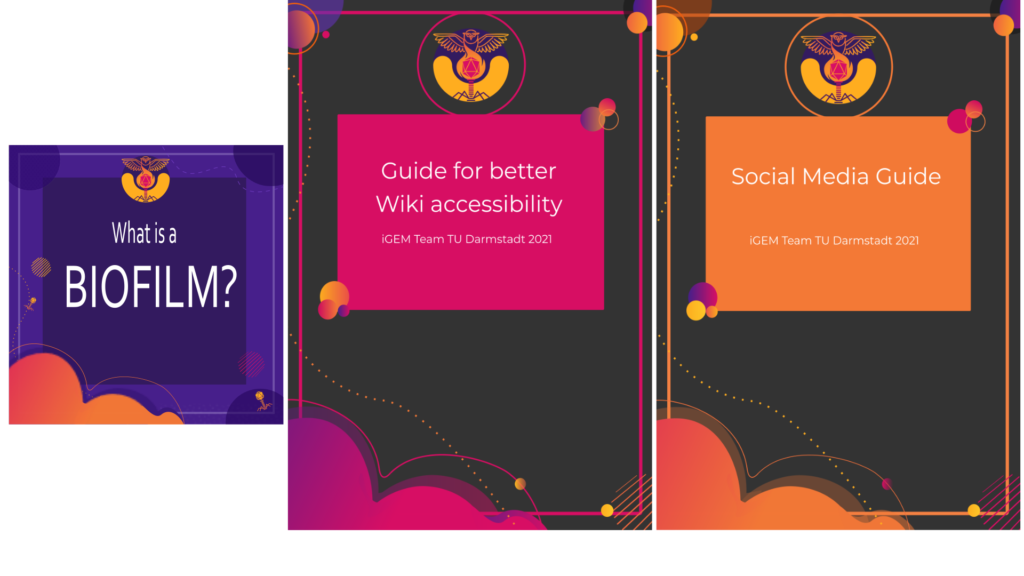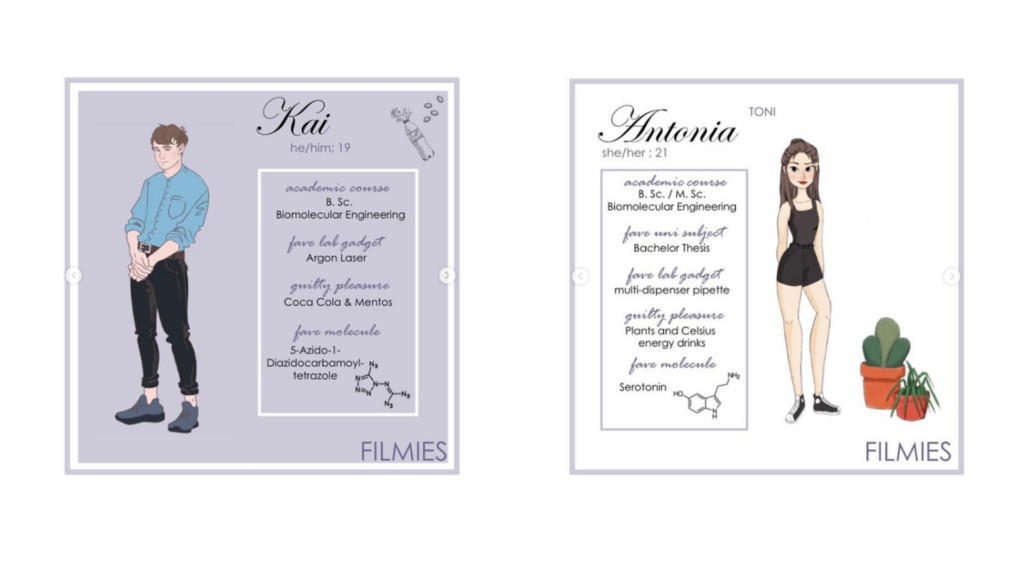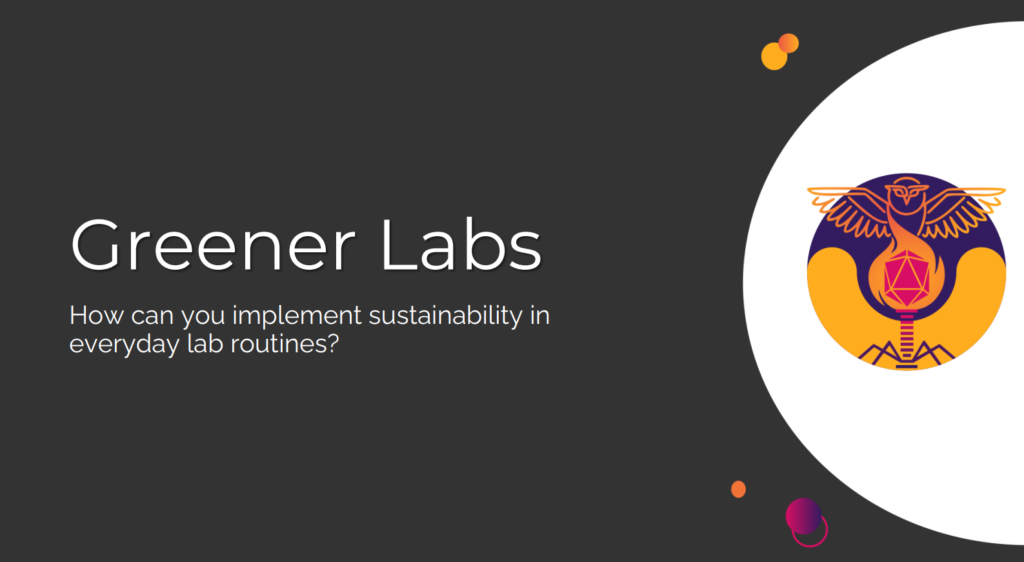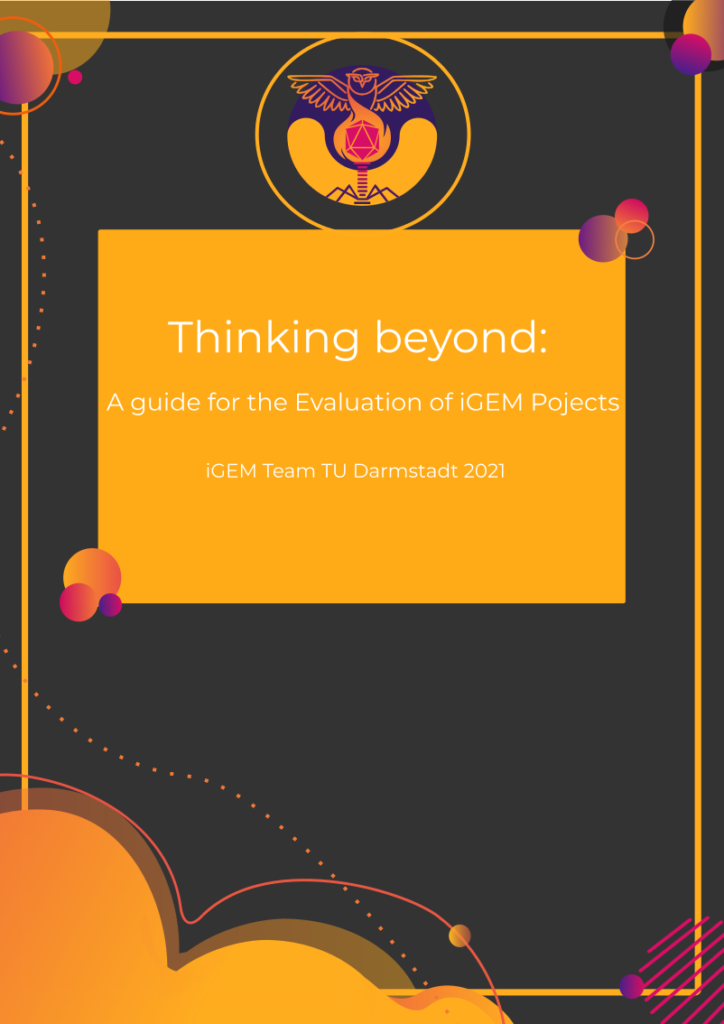Introduction
Excellence in another area means to work on topics which are of personal concern to the team although they do not refer to a specific requirement of iGEM. Thereby, we laid our focus on reaching future iGEM Teams as well as the whole science community making it easier for them to tackle important issues. We therefore used different strategies to reach our goals.
One of these goals was to raise awareness for sustainable laboratory work in science holding a Greener Labs coffee lecture to address active researchers.
For us, it also was of great importance to methodically evaluate ethical and safety aspects from various angles. In order to help future iGEM Teams to do the same, we wrote a Handbook filled with all our knowledge on this topic. With that we wanted to do our part to ensure the safety and responsibility of the future of science.
Branding is an essential part of the iGEM project, since it can assist but also hinder effectively on the way to success. All the tips and tricks for how to brand an iGEM project are written down in the Social Media Guide.
Greener Labs

Inspiration: Sustainable Research Symposium
Since we as young scientists aim to work more sustainable in the lab, we joined the “Sustainable Research Symposium” (SRS, external) – an event uniting students and people interested in science from all over the world. We gained new insights on how to think and act in a more responsible way in order to contribute to stepwise improvements in lab routines and everyday life. It became clear to us that the cooperation and communication between politics, science and industry is crucial for achieving the Sustainable Development Goals (SDGs).
The presentations brought our attention to problems affecting wet and dry labs. We became aware of the fact that plastic in labs accumulates to approximately 5 % of the global plastic waste. The research time often takes priority, so a lot of plastic consumables are used only once and then thrown away, even in cases where they could have been reused. However, here is a glimpse of the input we got in achieving green changes in our labs with small steps:
- reducing, reusing and recycling equipment in working spaces e.g., replacing plastic flasks with glass ware; reusing plastic, which does not require sterile usage conditions
- inspiring each other to be more environmentally friendly by involving greener habits in daily routines
- using “take-back-systems” of companies, which consist of sending back e.g., polystyrene boxes for free and therefore keeping the box in the reusage cycle. By that, money is saved and additionally it is extremely environmental-friendly.
Due to the pandemic, we are using more and more digital formats for modeling or simulating lab experiments, which also affects the environment. Talking in numbers, the 100 ns molecular simulation of the Satellite tobacco mosaic virus structure can cause up to 98 kg carbon dioxide emission depending on the software used.
Apart from the learnings on wet and dry labs, we gained another perspective on thinking sustainable regarding social justice. It was shocking for us to learn that nitrile gloves, which are used excessively during the lab routine, are produced in Malaysia, while labor practices applied in the factories are far away from being conform to human rights. The only thing we see of the whole story are the cheap nitrile gloves we throw away without being conscious about their real price.
All in all, the symposium was mind-opening and made us reflect issues we had not considered before. We must keep in mind that our actions, even if they do not seem to have a direct impact on our lab work, can be decisive and determining for the future of our planet.
Coffee Lecture
For spreading awareness, we aimed to organize a coffee lecture with students and researchers. Prior to that, we tried to get input from different experts in order to improve our work. We are very thankful to Prof. Nico Bruns for the great help and ideas as well as Dr. Nikoline Borgermann for the advice and feedback regarding our concept. Furthermore, the Sustainability Office at our university provided us with great support.
Here we want to list some of the alternative possibilities that lead to more sustainability, which were addressed during these meetings:
- A lot of chemicals are used even when they are not necessarily needed. Prof. Bruns suggested the usage of a so called “traffic light system” that could enable a quick, general classification of chemicals based on their potential environmental hazardousness.
- Pooling of lab equipment, which is either huge, energy-consuming and/or expensive. This sharing principle enables financial and environmental cost reduction.
- A very important point is to inspire other people and invite them to join the goals of Greener Labs. Such fundamental issues cannot be tackled by individuals. Only as a community, sustainable lab movements will have a useful impact.
- Every working group could try to develop an internal system, in which one would be given a small “reward” for being greener. This could then be established as a trend on our campus.
All in all, we are happy to provide you with our final presentation! It is conceptualized to be used as an inspiration or a small guideline for everyone trying or willing to achieve greener changes!
Reflexion
After the presentation we received really encouraging feedback. We were glad to hear that the idea behind Greener Labs seemed to be attractive for all participants. As some of them mentioned, it is important to raise awareness about such topics and also exchange opinions with each other. Also, the quiz was a great interaction opportunity and it had the desired impact on our audience. Moreover, we got different suggestions and recommendations on how to further develop our concept. One of them was the creation of a survey for lab workers that aims to estimate the importance of having a sustainable laboratory. Adding more stickers at the exit of the laboratory could be a useful reminder regarding switching off of all electric devices instead of keeping them in stand-by mode. During the discussion, we were able to collect proposals that would affect even bigger structures than laboratories. In relation to energy consumption, a big step could be the switch to renewable energies at the whole university campus.
We highly enjoyed having the opportunity to share our work and ideas. Almost all the PhDs and lab workers we talked to would be very happy to involve greener habits in their research. Now, we feel greatly motivated to go the next step: Implementing more sustainable methods and habits on our campus and further networking with other universities for the green purpose.
Thinking Beyond
A guide for the Evaluation of iGEM Projects
What is the most essential part of iGEM? Why do we work so hard in the laboratory? We want to find solutions for the small and the big problems not only on a national level but also on a global level to help people with our work!
But what if a scientist of synthetic biology is so wrapped up in his work, that he does not consider the possible consequences or even the potential misuse of his research? Exactly, the environment or even peoples lives and their well-being could be affected in a tragic way!
The most urgent matter is therefore to determine how we prevent this from actually happening. How can we protect our world and the people that are living in it? Throughout our iGEM year, our team thought and discussed about this matter extensively. These talks and thoughts were the main driving force behind our decision to evaluate how our project is received by the general public and by relevant stakeholders as well as identifying the possible impact, negative and positive, of our project on the society and on our world.
As our project PHIRE BYRD is quite complex, it was important to us to examine it from different angles and perspectives to ensure that we did not miss a single thing. Therefore, we talked to various scientists, ethicists, ministries etc. according to the Responsible Research and Innovation concept (RRI) and adjusted our project according to their input which resulted in our project being under a constant evaluation and development process. To reach people out of the scientific or biological field and be able to take their opinions and feelings into account, we conveyed a survey. Due to it, we received a lot of feedback about science communication, synthetic biology and genetically modified organisms including their fears about them and the consequences they anticipated for our project idea.
After this extensive evaluation process, the next step was to ask ourselves: “How can we help others with the experiences we had and the work we did as a team?”
To help others getting started with and structure their Human Practices work, we decided to share two tools that helped us tremendously:
1) The CEA framework
It is important to consistently assess how your project is received by the general public and by relevant stakeholders. Their input, whether it is fear, advice or approval, needs to be included into the evaluation and the execution of your project.
Our Human Practices team made an extensive effort to evaluate the impact of our project on the society and the global community. For the evaluation we relied on the input from the general public, scientists, ethicists and government officials.
To make sure that our work and its way of presentation were structured accordingly, we took a look at different frameworks we could use as inspiration for the creation and introduction of our own strategy. The resulting CEA framework shown in Figure 1 (short form of Consider, Evaluate and Adapt) laid the scaffold for the organization and the subsequent presentation of our Integrated Human Practices work. It is an adjusted version of the AREA framework according to our research procedure. As already mentioned, we named it CEA, standing for Consider, Evaluate and Adapt.

With Consider the first two steps of the AREA framework “Anticipate” and “Reflect” are combined. In it, not only the possible impact areas, positive and negative, of our project PHIRE BYRD but also potential stakeholders are being mapped out. During the next step, Evaluate, the focal point is the interaction with the previously mapped out stakeholders by scheduling and being part of conversations with scientists, ethicists and government officials and by conveying a survey for the general public to get input (feedback, recommendations, etc.) on our project.
In the final step of the CEA framework, Adapt, everything collected from the previous two steps of the framework is included in the decision on how to pursue the project further. During this phase of the cycle, one can also stumble upon new angles and perspectives of the project that initiate a new cycle.
2) Handbook
Secondly, to help other iGEM Teams evaluate their own project from different angles and perspectives, we wrote a Handbook which provides guidelines on how to ethically evaluate an iGEM project. This should make it easier for future teams that are unsure whether their project is safe for society to assess their project idea. Our Handbook grants a step-by-step guide with examples, idea boxes, suggestions and tips on various aspects regarding their iGEM project.
Branding
Every year, people from all over the world come together with new ideas, form a team and take part in the iGEM competition. But sometimes even if you have an amazing idea, it does not get the recognition it deserves because of a missing marketing strategy. At the end of the day, if you do not present your idea in a way that sticks to people’s minds, only a few will remember you and your project. Design and internet presence play a huge part in turning your idea as well as your team into a “brand” with recognition value. Synthetic biology becomes more and more important. In order to help other teams succeed in this area, build a platform and be remembered, we created a social media guide. Using real examples from our team, we explain the general concepts of design as well as ways to promote your team and project on prominent social media platforms like Instagram.
Design and Art
At some point, it is important to choose a logo, color palette and a design style to stick to for a long period of time. It is quite normal for a brand to redefine itself after some time but that should not be done unless its platform is already very big or its current strategy is not working out anymore.
The logo, color palette and design style should harmonize with each other. Generally, this can be accomplished as follows:
- The colors of your logo should at least be part of your color palette
- The colors in designs (for example, for pdf sheets, letters, flyers or even team merch) should be from the color palette
- The design style should match the style of your logo
The most important part is that your overall identity harmonizes in a way that actually represents the project and creates a recognition value. This includes your logo, design and (project) name.
If you take a look at our logo, you can see that we integrated two big parts of our project idea. On the one hand, we have the phage and on the other hand, we have a yellow shape that represents an abstracted form of a cell. Furthermore, we integrated an owl which has established itself as the representative emblem of the TU Darmstadt teams in the past and was inspired by the Athena in the logo of our university. The last component in our logo is the fire which, combined with the owl, connects our logo with our project’s name “PHIRE BYRD”.
The colors of our logo are the basis for our main color palette, which we used for our wiki, pdf designs, flyers and posts on social media (Figure 2). To match our overall design style with our logo, it is important to take a look at the shapes and general style of it. Regarding shapes, we have a good mixture of circles, rectangles, triangles and oval features. This basically allows us to use every type of shape in our design style. However, it is important how often each shape is used. Since the overall logo is round, using rectangles with rounded corners is a good fit. That is why it is found on our wiki so often.
Generally speaking, our overall design concept is rather abstract because no specific application hint is included. Since we created a modular system, keeping the design style more neutral and classic yet abstract fits this idea perfectly. Therefore, if a team is e.g., competing in the environmental track and the topic is water or water quality, it would make sense to include a reference to the specific application. This can be achieved with wavy or flowy designs as well as the usage of the color blue. When someone listening to your presentation or looking at your wiki sees this logo, they can more easily associate the logo with the idea. If you then manage to include in your design what makes your project special – for example compared to other water purification approaches – then chances are high a person will remember your idea by simply looking at your logo.

Social Media
In January 2020, 3.8 billion people were using social media worldwide.1 Additionally, more and more people are joining social media platforms each year. Therefore, having a social media presence is very crucial and it can be used as an effective tool to reach out to stakeholders from different fields if used correctly.
We focused on promoting our team and project on social media by following a clear timeline and strategy this year. To find an optimal upload timing, we took our account statistics into consideration, which showed us when our followers were most active. Moreover, we introduced specific formats which were posted on specific days. One of those formats was the “Member Monday” where we introduced our team members. To attract more attention, we made little comic-styled drawings of each member (Figure 3) and tried to be as creative as possible. Another format was the informative posts where we talked about different aspects of our project, like biofilms or B. subtilis. This can also be a great overall strategy for an iGEM Instagram account. Thereby you introduce the small parts that form your project step-by-step and then reveal your actual project idea and show how these smaller parts work together. With this strategy, it is also easier for people who do not know as much about synthetic biology to understand your project. With the slide tool on Instagram, you can post multiple pictures at once. Therefore, you can make a cover with the main topic of the post as shown in Figure 2 above, which will make it easier for people to find a certain topic on your page.

Collaborations are of great importance in the iGEM Competition. It is quite easy to get in contact with other teams via social media. Besides private chats, you can also create group chats with multiple teams. Additionally, a lot of teams post about their projects, which facilitates finding a team with whom a feasible collaboration is possible.
Besides collaborations, challenges are also a great way to engage with other teams. We did not only participate in challenges but also made up some on our own. Last year’s team of the TU Darmstadt initiated the iJET challenge for the first time and this year we gave it a comeback.
In addition to the posts on your account’s feed, you can also use your story for posts that are available for 24 hours only. If you want a story post to be seen after that time span, you can create a story highlight which will be visible on your account. There you can also group specific posts into one highlight. We used this a lot for our time in the lab. Story posts are a great fit to promote something, to make polls and for more casual posts. Whether it is a funny failure in the laboratory or the eventual moment of success, these situations are familiar to many people – not only those who participate in iGEM. Showing these moments will present you in a more authentic and sympathetic way, which will make other people want to engage with you more than if you only post elitist and professional content. This is especially helpful for succesful science communication and the inclusion of the broad society into your research.
References
- 1. Kemp S. Digital 2020: Global digital overview. Dtareportal. [accessed 2021 Oct 8]. https://datareportal.com/reports/digital-2020-global-digital-overview



